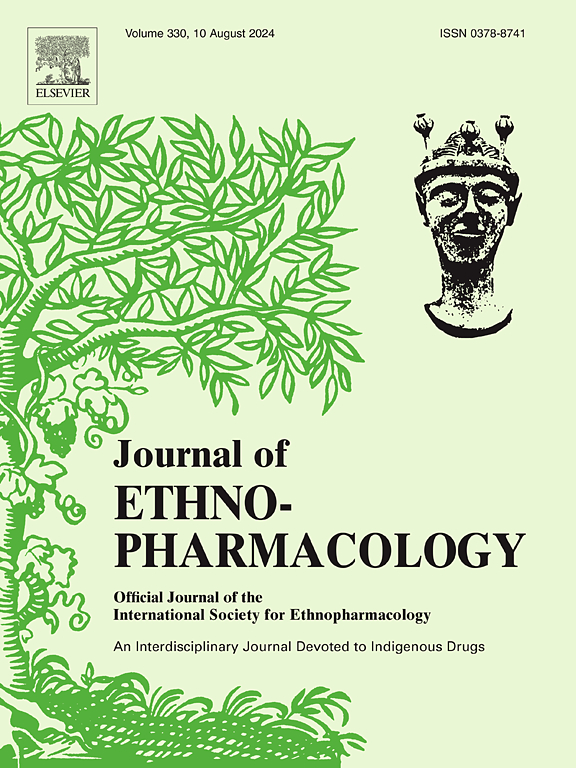四翅目四胸膜果。& Thonn)。陶布。通过网络药理学、分子对接与动力学以及体外研究,揭示了其抗前列腺癌的前景
IF 4.8
2区 医学
Q1 CHEMISTRY, MEDICINAL
引用次数: 0
摘要
癌症是一个主要的全球公共卫生问题,对生活质量和治疗结果有重大影响。四胸草(Tetrapleura tetraptera, TT)等药用植物是具有治疗潜力的生物活性化合物的重要来源,但其功效和潜在的分子机制仍未得到充分研究。目的探讨TT的抗前列腺癌作用、抗氧化活性及其作用机制。材料和方法采用粉末TT(全果、果肉和种子)依次提取粗提取物。采用DPPH自由基清除法、Folin-Ciocalteu法和四氮基比色法分别测定TT提取物的抗氧化活性、总酚含量和抗前列腺癌活性。通过文献挖掘和公共数据库鉴定了TT和前列腺癌相关靶点的生物活性化合物。利用网络药理学、分子对接和分子动力学等方法对TT的潜在作用机制进行了研究。结果全果水提取物具有较强的抗氧化活性,其EC50值为83.46±1.07 μg/mL,乙酸乙酯提取物的抗前列腺癌活性最强(PC3 IC50值为5.39±1.24 μg/mL, SI值为7.72;LNCaP IC50 = 8.38±1.27 μg/mL, SI = 4.97)。网络药理学发现TT化合物靶向前列腺癌通路中的关键蛋白,涉及MAPK, PI3K/AKT和P53信号级联。分子对接和动力学模拟进一步支持了这些发现,证明木犀草素与MMP9/AR和东莨菪素与ERBB2之间存在强大、稳定和灵活的结合相互作用。结论TT果实通过多靶点调控关键信号通路的关键蛋白,具有良好的抗前列腺癌活性。然而,需要进一步的体外、体内和临床研究来验证这些发现,并充分挖掘TT的治疗潜力。本文章由计算机程序翻译,如有差异,请以英文原文为准。

Tetrapleura tetraptera fruit (Schumach. & Thonn.) Taub. as a prospective anti-prostate cancer agent revealed through network pharmacology, molecular docking and dynamics, and in vitro studies
Ethnopharmacology relevance
Cancer is a major global public health concern with significant ramifications on quality of life and treatment outcomes. Medicinal plants such as Tetrapleura tetraptera (TT) are key sources of bioactive compounds with therapeutic potential, yet their efficacy and underlying molecular mechanisms remain largely unexplored.
Aim of the study
To investigate the anti-prostate cancer potential, antioxidant activity, and underlying mechanism of TT.
Materials and methods
Crude extracts were obtained through the sequential extraction of powdered TT (whole fruit, pulp, and seed). TT extracts were assessed for their antioxidant activity, total phenolic content and antiprostate cancer activity using the DPPH radical scavenging assay, Folin-Ciocalteu method and tetrazolium-based colorimetric assay, respectively. Bioactive compounds from TT and prostate cancer-related targets were identified through literature mining and public databases. Network pharmacology, molecular docking and molecular dynamics were employed to elucidate TT's potential mechanisms of action.
Results
Aqueous whole fruit extract exhibited potent antioxidant activity with EC50 = 83.46 ± 1.07 μg/mL, while the ethyl acetate fruit extract showed the strongest anti-prostate cancer activity (PC3 IC50 = 5.39 ± 1.24 μg/mL, SI = 7.72; LNCaP IC50 = 8.38 ± 1.27 μg/mL, SI = 4.97). Network pharmacology revealed that TT compounds targeted key proteins within the prostate cancer pathway, implicating MAPK, PI3K/AKT and P53 signaling cascades. Molecular docking and dynamics simulations further supported these findings, demonstrating strong, stable and flexible binding interactions between luteolin with MMP9/AR and Scopoletin with ERBB2.
Conclusions
Whole TT fruit demonstrates promising anti-prostate cancer activity through the multitargeted modulation of key proteins involved in pivotal signaling pathways. However, further in vitro, in vivo and clinical studies are required to validate these findings and fully explore TT's therapeutic potential.
求助全文
通过发布文献求助,成功后即可免费获取论文全文。
去求助
来源期刊

Journal of ethnopharmacology
医学-全科医学与补充医学
CiteScore
10.30
自引率
5.60%
发文量
967
审稿时长
77 days
期刊介绍:
The Journal of Ethnopharmacology is dedicated to the exchange of information and understandings about people''s use of plants, fungi, animals, microorganisms and minerals and their biological and pharmacological effects based on the principles established through international conventions. Early people confronted with illness and disease, discovered a wealth of useful therapeutic agents in the plant and animal kingdoms. The empirical knowledge of these medicinal substances and their toxic potential was passed on by oral tradition and sometimes recorded in herbals and other texts on materia medica. Many valuable drugs of today (e.g., atropine, ephedrine, tubocurarine, digoxin, reserpine) came into use through the study of indigenous remedies. Chemists continue to use plant-derived drugs (e.g., morphine, taxol, physostigmine, quinidine, emetine) as prototypes in their attempts to develop more effective and less toxic medicinals.
 求助内容:
求助内容: 应助结果提醒方式:
应助结果提醒方式:


